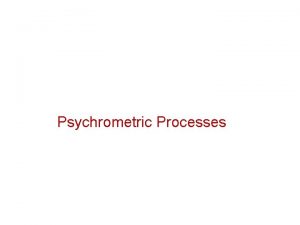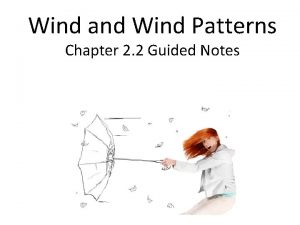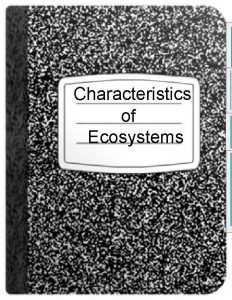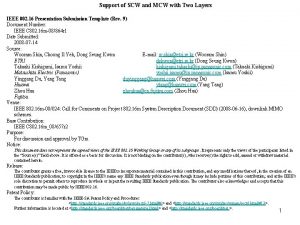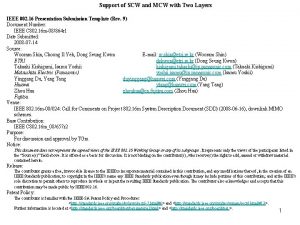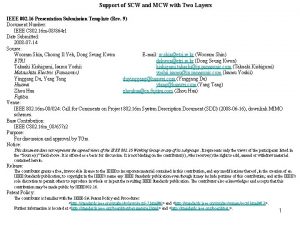Support of MCW up to Two Streams for




- Slides: 4

Support of MCW up to Two Streams for Each Layer IEEE 802. 16 Presentation Submission Template (Rev. 9) Document Number: IEEE C 802. 16 m-08/864 Date Submitted: 2008 -07 -14 Source: Wooram Shin, Choong Il Yeh, Dong Seung Kwon E-mail: w. shin@etri. re. kr (Wooram Shin) ETRI dskwon@etri. re. kr (Dong Seung Kwon) Takaaki Kishigami, Isamu Yoshii kishigami. takaaki@jp. panasonic. com (Takaaki Kishigami) Matsushita Electric (Panasonic) yoshii. isamu@jp. panasonic. com (Isamu Yoshii) Yinggang Du, Yang Tang duyinggang@huawei. com (Yinggang Du) Huawei ytang@huawei. com (Yang Tang) Zhou Hua zhouhua@cn. fujitsu. com (Zhou Hua) Fujitsu Venue: IEEE 802. 16 m-08/024: Call for Comments on Project 802. 16 m System Description Document (SDD) (2008 -06 -16), downlink MIMO schemes. Base Contribution: IEEE C 802. 16 m_08/657 r 2 Purpose: For discussion and approval by TGm Notice: This document does not represent the agreed views of the IEEE 802. 16 Working Group or any of its subgroups. It represents only the views of the participants listed in the “Source(s)” field above. It is offered as a basis for discussion. It is not binding on the contributor(s), who reserve(s) the right to add, amend or withdraw material contained herein. Release: The contributor grants a free, irrevocable license to the IEEE to incorporate material contained in this contribution, and any modifications thereof, in the creation of an IEEE Standards publication; to copyright in the IEEE’s name any IEEE Standards publication even though it may include portions of this contribution; and at the IEEE’s sole discretion to permit others to reproduce in whole or in part the resulting IEEE Standards publication. The contributor also acknowledges and accepts that this contribution may be made public by IEEE 802. 16. Patent Policy: The contributor is familiar with the IEEE-SA Patent Policy and Procedures: <http: //standards. ieee. org/guides/bylaws/sect 6 -7. html#6> and <http: //standards. ieee. org/guides/opman/sect 6. html#6. 3>. Further information is located at <http: //standards. ieee. org/board/pat-material. html> and <http: //standards. ieee. org/board/pat >. 1

SCW vs. MCW SCW Pros MCW • Spatial diversity gain • Higher spectral efficiency by link • Small UL feedback overhead for adaptation gain semi-static SU/MU mode • SIC receiver using FEC decoding adaptation result • Flexible SU/MU mode adaptation by per-steam CQIs • Near-ML receiver required for higher spectral efficiency • Large UL feedback overhead comparable to MCW for dynamic Cons SU/MU mode adaptation • Large UL feedback overhead for semi-static SU/MU mode adaptation 2

MCW with up to Two Streams for Each Layer • Each layer can be transmitted over up to two streams. • Good tradeoff between higher UL feedback overhead of MCW in semi-static SU/MU mode adaptation and less flexibility of SCW for maximizing sum-rate in dynamic SU/MU mode adaptation – CQI feedback methodology is FFS. – BS can control the number of streams for each layer, which depends on the degree of user load. It is FFS. Thus, both SCW encoding and MCW encoding with up to two streams for each layer should be employed for semi-static and dynamic SU/MU mode adaptation, respectively. 3

Suggested Remedy • At line 20 -21 in page 4, change the original sentence as follows, – For SU-MIMO, both SCW (or vertical) encoding and MCW (or horizontal) encoding up to two streams for each layer is are employed. [The support of MCW for SU-MIMO is FFS]. 4

